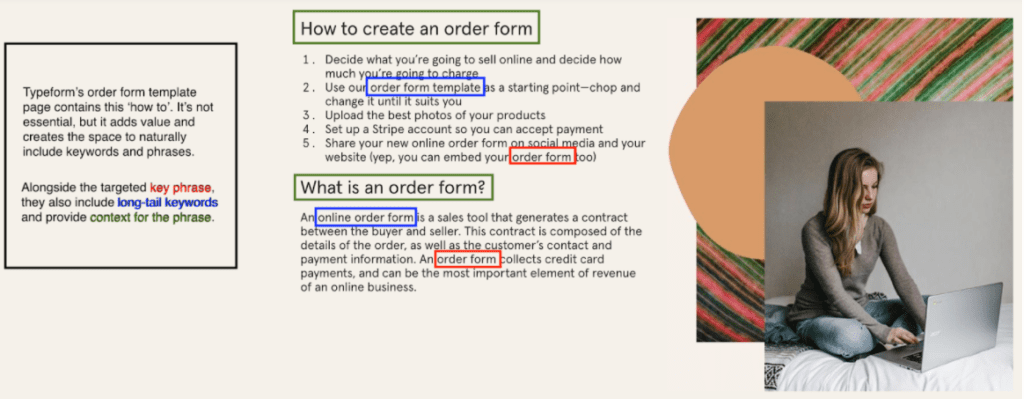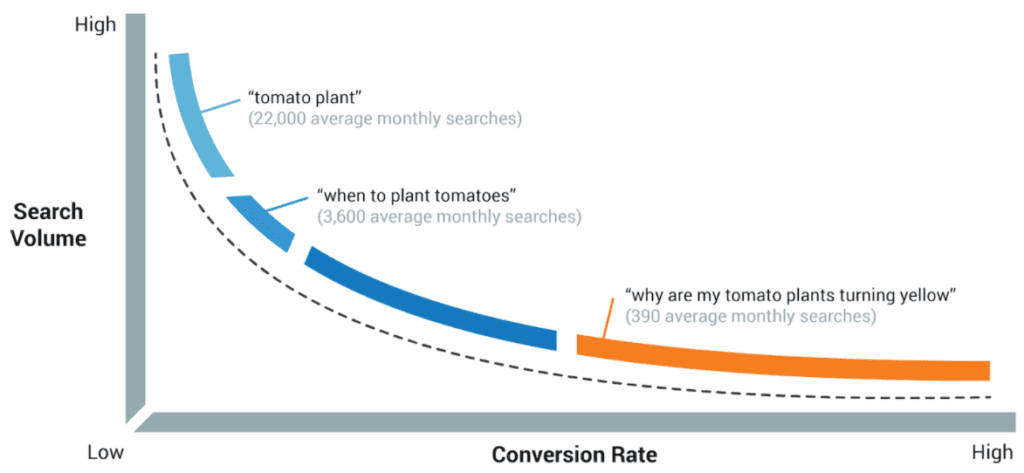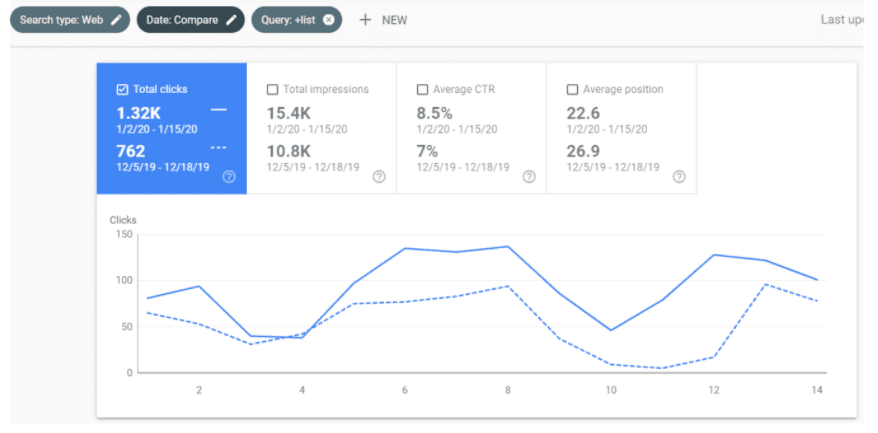Fun fact: The number one organic search result on Google receives 31.7% of all clicks. Less than 1% of all Google searchers click through to the second page of results.
If you want your business to grow, you absolutely MUST get your content ranked on page one of the SERPs.
However, a lot of marketers and business owners get confused when trying to keep up with the latest SEO best practices.
In this post, we’ll explore a few strategies you can implement to improve your position on SERPs without spending a cent.
5 Ways to Optimize Content for More Clicks and Better Rankings
1. Use Keywords that are Relevant to Your Content
Google has gotten pretty darn good at deducing whether your content reflects what the title tag says it is. You can’t trick the algorithm anymore, so be sure to choose keywords closely aligned to the content itself.
No matter how amazing your content might be, its ability to rank will depend heavily on selecting appropriate keywords to target.
The Google Hummingbird update flipped the algorithm on its head, where it no longer focused on individual keywords. With Hummingbird, Google began to rank based on intent of the search as compared to the meaning of the phrase / keyword in it. This change resulted in brands having to think and type more like humans, rather than bots.
For you to achieve maximum benefits from organic, you’ll need to merge keyword and topic clusters. And you need to deploy it live to the web site the right way.
Bad SEO practices include things like keyword stuffing, uncomfortable copy, and hidden phrases— like font color matching background color, a practice we in the SEO industry refer to as keyword cloaking. Google frowns on any of these sneaky, black hat efforts to trick the algorithm.
There are other white hat ways to improve your ranking. For example, add more content to provide additional information around a product or service on your website. This will help Google expand their understanding of what similar topics might be relevant to the page.
Tactics like this are a great way to add keywords and phrases on a page and provide value. Take a look at the example below from the Typeform, order form landing page.

Consider looking into and using long-tail keywords, phrases of three or more keywords, to attract more relevant traffic to your page.
Alongside your shorter target keywords, they’ll help users find you on more specific and relevant searches — think ‘raincoat’ vs. ‘yellow raincoat with a hood.’

2. Be Smart About Your Page Titles
The title tag of a web page is one of the most critical components of on page SEO. Not only is it the first place search engine spiders look for keywords, but it is also what will be most noticeable to potential visitors when it shows up on the SERPs.
Keep Page Titles Short
If your title tag is longer than 50-60 characters, or 600 pixels to be precise, it will most likely be cut off on the SERP. Instead, it will appear with an […] in place of the full title.
Alternatively, you will want to have your desired title appear in full on the SERP. Aim for an example like the one below.

Consider using a title tag tool to simulate the way it will actually appear on the SERPs. It can help you find things to improve before you officially place the new page title on the website.
Always Start With Keyword Selection
Picking keywords is only half the battle. You’ll find that it is equally important to be smart about where you use these keywords.
You want your important target keywords toward the beginning of the title tag. Search engines read the page title from left to right, and the first several characters are the most important.
If brand awareness is also important, be sure to include your brand at the end of all page titles. Between the domain itself and the page titles, you can get multiple mentions of the brand on every single page on the domain.
This will benefit you with awareness, yes, but also open up the possibility of ranking #1 for a range of keywords that combine your brand name with the keywords you are targeting in the content itself.
Do not sacrifice quality for keywords.
Relevant Page titles Are Easier to Get Indexed
Search engines have gotten really good at understanding the content on your page and can decide whether your title tag is relevant to your content. If it’s not, it won’t rank as well, and fewer users will end up visiting the pages where this disconnect lies.
TrustRadius was able to identify a best performing title tag convention for their content and doubled down on the strategy.
They increased their CTR by 73% on some high-value pages and continued to increase traffic once the tactic was applied site-wide.

3. Meta Descriptions Will Make Or Break Your Click Thru Rates
The meta description attached to your page describes the content to searchers.
Try to focus on accurately describing your content and targeting your desired keywords in your description in order to generate more clicks.
Search engines will bold keywords on the results / listings, which in turn makes it super easy for users to scan the listing and find the keyword they searched for. This too can really help improve your click thru rates on organic searches.
Similar to title tags, meta descriptions are also subject to character constraints.
Limit your meta descriptions to 256 characters to ensure it appears in full on the SERP. Don’t use the same meta description site-wide— every page on your website is different, and the meta descriptions should reflect this.

4. Optimize Images for SEO
90% of the information the brain receives is visual. None of us should be surprised to learn that early adopters of visual search capabilities can expect to see a 30% increase in digital commerce by 2021. I recommend you optimize early and often for visual search.
Ideally, use original, relevant images in your content. Once you have your images, you can build on your SEO efforts by naming your file in line with its content— which should match your page’s broader content theme. and include target keywords where appropriate.
As a general rule aim to:
- Stick to 3-4 words
- Bring keyword(s) toward the beginning of the filename
- Keep it short and descriptive
- Separate words with hyphens not underscores, which can confuse search engine crawlers
It’s also important to consider which file type to use in each image opportunity. JPEGs are great for larger images or illustrations, while SVGs are ideal for icons and logos. PNGs are useful for smaller images that may appear sitewide or in persistent content.

Scale your images to fit the display area available. This will help improve load times and allow crawlers to index your page quicker.
It’s also essential you use responsive images to provide the same experience when a user is browsing on mobile, which now accounts for over 50% of internet traffic and is growing by the day.
When optimizing your images for search engines, don’t overlook image title and alt-text. These describe the image if it doesn’t appear or isn’t visible to a user and is crawlable on page content for search engines.
Include keywords in the alt-text where appropriate, and remember to remain human in your copy.
As an added benefit, image optimization improves the accessibility of your website for vision impaired users.
5. Create Captivating Content
Linkbait is content that has been created in the hopes that others will share it and link back to your page.
Despite the essential role of backlinks in successful SEO, 75% of web pages have no external links back to them. This represents the single most important strategic shift you can make if you want to see improving SEO results in the long run.
Some types of content are more shareable than others. If you play your cards right, you can generate content that will really urge people to share forward.
There is, of course, an emotional driver behind sharing content. Create your content with this in mind.
Look to call on one of these five emotions, as they’re the most likely to get your content shared:
- Awe
- Surprise
- Anger
- Anxiety
- Interest
You should also consider is using negative headlines. They perform 63% better when it comes to click-through rates.
Negative superlatives (e.g. worst or never) drive more clicks than positive superlatives (best or greatest). If it fits for your brand’s tone of voice, then try it out.
Alongside emotional buttons, strive to make your content as visual as possible. Infographics, charts, illustrations— these are all ways to win shares and links in modern digital marketing.
Wrapping up
Good SEO practices improve your chances of reaching a wider audience. If you are good at crafting captivating content and headlines, readers will be more likely to share it.
The way information is indexed and called on is in no way static. In fact, more and more SEO specialists are turning their focus to accommodating voice and visual searches as well.
According to a survey conducted by Adobe, a whopping 94% of users said they found voice search easy to use. And web marketers are paying attention — 91% of brands are now investing in voice compatibility or functions.
The future of SEO is dynamic. It’s a combination of adopting new trends, playing with emotions, optimizing for keywords, and creating incredible content.
Take your time with it, test strategies, and find the unique approach that works best for your business.
Image sources referenced inline throughout this blog post.
Disclaimer: The views and opinions stated in this post are that of the author, and Return On Now may or may not agree with any or all of the commentary.
This guest post brought to you courtesy of Return On Now, Professional Austin SEO and PPC Services Company.
Latest posts by Ray Slater Berry (see all)
- Reel Them In: How to Use On Page Optimization to Increase Organic Traffic - October 27, 2020




